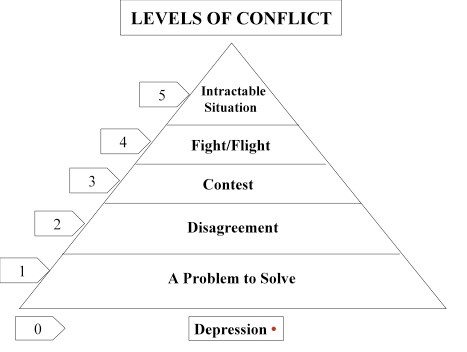Apparently, there are 413 commandments in the Bible. Why so many? [you might ask] Well, there has to be at least one we can keep!
But there are some commonly assumed commandments that are not there. “Thou shalt not be angry” is not one of the 10 commandments (just do not take God’s name in vain). Nor is “Thou shalt not have conflict” (but try not to kill your neighbour).
Conflict is perfectly natural. As human beings we don’t always agree and, of course, some things matter and cannot be ignored.
- Conflict in the Early Church
There are lots of examples of leadership problems and conflict in the Bible. I will briefly look at the Book of Acts, which is Luke’s account of the first years of the Christian church. It is totally realistic about issues faced. Paul and Barnabas disagreed about whether John Mark should accompany them on a missionary journey (Acts 15:36-41). Paul was reluctant because he felt let down when John Mark left them in Pamphylia. Luke observed, “The disagreement became so sharp that they parted company.” (v39). Indeed, Paul chose Silas as his companion. Barnabas went to Cyprus with John Mark. It is clear in Paul’s letters that he had later reconciled with John Mark, but clearly this is an example of unresolved conflict on a missionary journey. Both Paul and Barnabas were in ministry with the common purpose of sharing the good news of Christ, Paul was an apostle, and presumably both had the Holy Spirit – but they disagreed and at that time the issue was left unresolved.
The early church faced a number of problems. There was a cultural division between Jews and Gentiles. Some preachers demanded that early Gentile converts be circumcised when they became believers. In effect, to become Jewish as well as Christian. Their message was “Unless you are circumcised according to the custom of Moses, you cannot be saved.” (Acts 15:1) This was a potentially explosive issue, especially when Gentile believers were flooding into the early church. Paul and Barnabas debated with them and they decided to go to Jerusalem to seek advice from the apostles and the elders. Luke gives the account, “The apostles and the elders came together to consider the matter. After there had been much debate, Peter stood up and said to them, “My brothers, you know that in the early days God made a choice among you and that I should be one through whom the Gentiles would hear the message of the good news to become believers. And God who knows the human heart, testified to them by giving them the Holy Spirit, just as he did to us and enclosing their hearts by faith is made no distinction between them and us. Now therefore why are you putting God to the test by placing on the necks of the disciples a burden that neither our ancestors nor we have been able to bear?” (Acts 15:6-10) James also spoke. After much discussion the apostles and the elders, with the consent of the whole church, decided not to require circumcision from the Gentile believers.
Now what has been called the Jerusalem Council has implications for the structure of church leadership. However, it is slightly ambiguous. I can assure you that Roman Catholics and Anglicans find a precedent for the eventual roles of bishops and priests, the Uniting Church can see an early assembly or synod, and Baptists argue for an early congregational meeting. It is important to note that the issue was faced, allowance was made for disagreement and there was a genuine attempt to seek God for an eventual resolution.
- General Principles of Conflict
We can always expect conflict in the life of the church. If there is no disagreement, then it is likely that NOTHING of importance is being done. So, it is natural to disagree. Issues will change with time, but a tendency to have different perspectives will remain.
The issue is not to avoid conflict but to deal with it in a healthy way. For nearly 25 years in my work as a clinical psychologist I specialised in helping couples in distress. The most influential researcher in this field is Dr John Gottman. He did a longitudinal study of couples and it led to a number of surprises that changed couple therapy. He found that healthy couples, who rated their marriage as satisfying, still had what could be described as intense conflict. And most of their conflict remained unresolved. The couples kept fighting over the same issues year after year. When I realised this, I stopped trying to fix issues, instead I tried to help couples find better processes. Indeed, Gottman found that what was most important was how a couple delt with being ‘gridlocked’ or stuck in conflict (important because about 2/3rds of issues never resolve in a satisfactory way). All this equally applies to family and intergenerational conflict.
Reflect: In your close family or intimate relationship, what are the issues you face? Are you any closer to a resolution after years or even decades of disagreement?
Gottman identified the four horses of the Apocalypse as destructive processes in conflict and highly predictive of eventual separation and divorce. This included criticism, defensiveness, contempt, and stonewalling.
I will highlight just two: stonewallingis cutting off all communication with a barrier of silence. Contempt is personal and it is a high ground moral judgement on the other person, saying “I am superior and you are worthless.” It is important to avoid personalising conflict, but to try to honestly face the issues and to accept that sometimes convictions will remain unchanged. Hopefully, like in a good marriage we can still get on with each other.
- Application to GUC
The GUC community here has been through a difficult period. People were divided in their reaction to the ministry of Pastor Darren. Not everyone, had strong feelings about this but the leadership of the church were deeply involved in trying to work out the best way forward. There was a consultation and eventually it was determined that Pastor Darren did not have a continuing ‘vitality of call’ and he left in January 2022. There was a recent congregational survey as part of the Life and Witness Program of presbytery and there was some indication of unresolved feelings.
Rev Elizabeth Raine has challenged GUC leadership including Council to address this in a healthy way. I have proposed a three-step process which begins with this sermon.
What is the problem? I can almost hear this being asked by some with the rationale that Pastor Darren has left, so what needs to be resolved?
I would observe that the GUC went through a trauma. I am not blaming Darren for this, ministry is challenging and it is impossible for any style of spiritual leadership to be appreciated by all in a given church. But many in this church have been saddened to find a deterioration in relationships. A number of people left and will not return. For some there is an ‘open wound’. It is inevitable that such pain, left unhealed, will be triggered in the future. To use a psychological diagnosis it is the basis for a disorder such as PTSD when a battle veteran keeps reacting to any reminders of say being in Afghanistan.
The following is a model for levels of conflict. Think for a moment about what level of conflict you were engaged in, especially if you’re a leadership, or thought about the possibility of leaving this church or acted on it!

The benefit of this model is that it has a zero level of conflict in which has the appearance of conflict being fully resolved but it lies dormant and waits for someone to “poke the bear” (Elizabeth Raine). I am not a prophet but I will make a safe prediction. If we fail to address this issue, then you will call the new minister in placement and sometime in the first 6 to 12 months an issue will arise, and suddenly there will be intense emotional reactions out of all proportion to the issue at hand. You will need to be able to see, hopefully with a moment of clarity, that it is not an issue ‘caused’ by the new minister but a legacy of a previous trauma.
The second step is to take 30 minutes or so, at a time that is convenient to you, and fill out a reflection. This is a handout which I have put together and uses some of the resources of Elizabeth Raine. Hopefully you can use it to think about some of your emotional reactions. I think it will be useful and hopefully will help you to recognise when you are being triggered in the future.
The third step? This will be revealed to those who have completed the second step. So wait and see …
A Story of Reconciliation
Internationally, the best-known building in Australia is the Sydney Opera House. There is quite a background story. When the New South Wales government announced a competition for the design of the opera house 233 entries were submitted. One was by a little-known 38-year-old architect from Denmark Jorn Utzon. He proposed a striking design for the head-land at Bennelong Point. What do you ‘see’? Sails or shells or the wings of seagulls? One of the competition judges described his entry as a work of genius.
Utzon would often say that everything about the opera house was to be on the edge of the possible so this creation would be a place of human delight. Unfortunately, Utzon and the Opera house management fell into a serious rupture. Instead of being the making of this young architect the project nearly ruined him. The assignment was ambitious and it was a vision that many did not understand. The New South Wales government had issues with deadlines and overblown expenses. They forced Utzon to leave Australia when the project was only two thirds finished. The final stages of construction were completed with little regard to the original design. Utzon faded into the background. In the following years he worked on very few projects and spent many years in silence. When the opera house was finally opened by Queen Elizabeth in 1973 Utzon did not attend.
Happily, the story does not end there. 30 years later, after decades of silence between Utzon and the Opera House Trust, the trust renewed communication with Utzon and asked him to prepare a set of design principles so that future stewards of the building would know his original intentions. Utzon agreed. Then in 2004 a small extension was added to the building and a sign was attached:
Western Colonnade Project Architect Jorn Utzon.
Utzon was 87 years of age at that time. And when the new Colonnade was opened by Queen Elizabeth in 2006 he couldn’t travel. So he sent his son, Jan Utzon. The Sydney morning Herald article remarked “Rifts between architects and their clients are commonplace, reconciliations are rare.” Peter Walker (principal of UTC) observed about this story, “The story of an architect of a troubled masterpiece on Sydney Harbour and over which he lost control. He did not think stop thinking about it even for a single day. But the architect was eventually returned to his rightful place and his son marked his presence at the time of reconciliation.” God, too, provided his Son to mark his presence at the time of our reconciliation.
I would also note that on the other side of conflict a beautiful building can be found on Sydney harbour.
I would encourage everyone who was affected by the conflict to proceed to Stage 2 and to find 30 minutes to fill out the reflection. And then later find 15 minutes to complete Stage 3.
Rev Dr Bruce A Stevens is a clinical and forensic psychologist. He is a supply minister at GUC.


